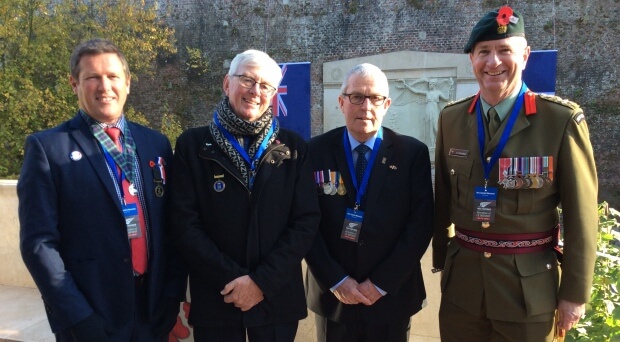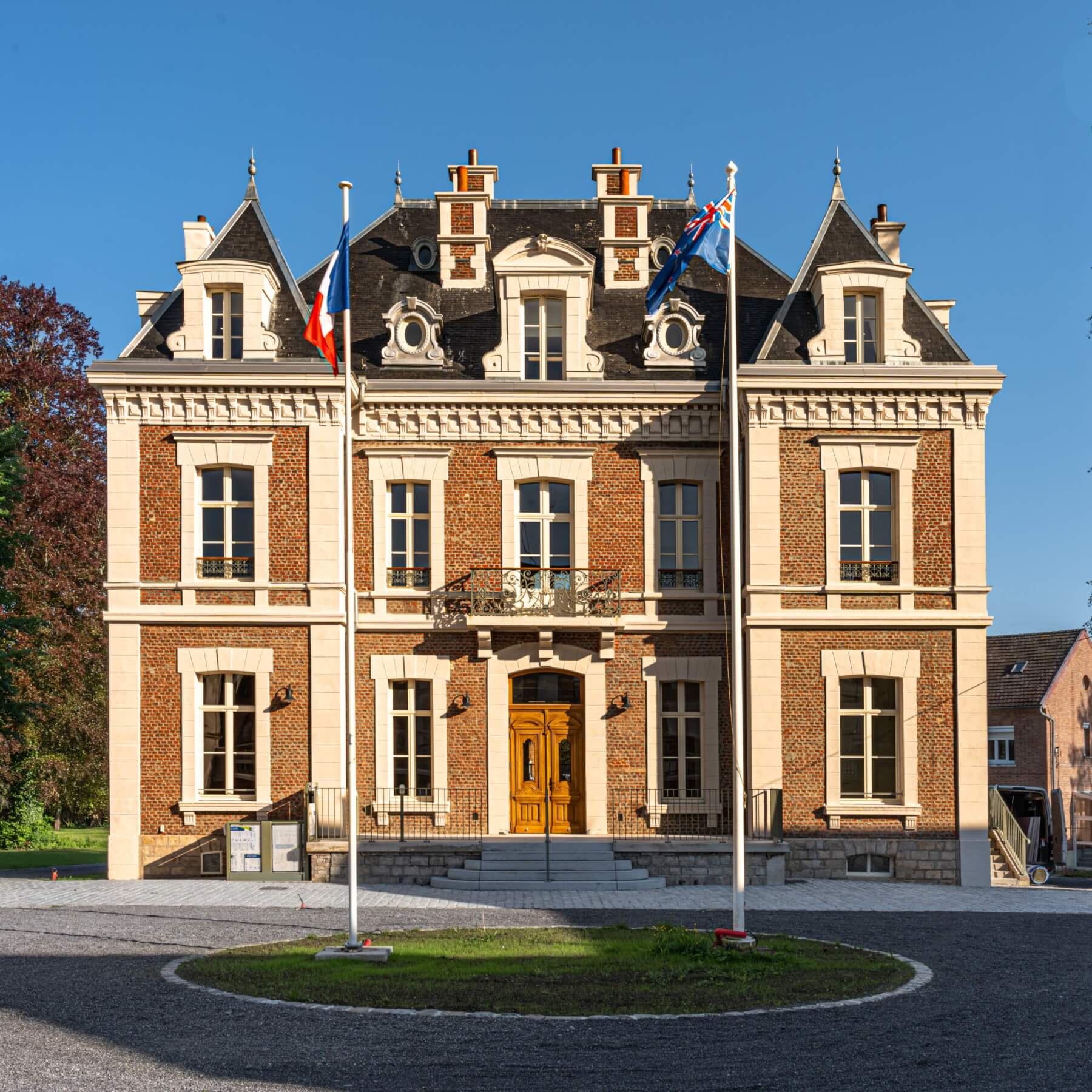
Three of the Kean boys from Southland served in Europe during World War One but only two came home.
Private Denis Kean fought in Gallipoli and then, in 1916, was wounded at Ypres on the Western Front. After being wounded a second time at Passchendaele in 1917 he returned home to New Zealand.
Denis’s younger brother Private Jack Kean was wounded in the Somme and older brother, Rifleman Peter Kean, was wounded at Messines in 2017.

Peter Kean. Photo: Gore Historical Museum.
All three brothers posed for a photo while on leave in London in June 1918 – it was the last time they would be together.
“They would have enjoyed meeting each other in London while on service leave. It would have been special,” says Peter’s great nephew Steve Tritt whose grandmother, Walterina Mary Kean (known as Lily), was Peter’s little sister.
“Jack was badly disfigured when he was shot in the face during the Somme advance. He returned home, married late in life at 50 and had two children. Sadly, Peter went back to the Front and was killed during the Liberation of Le Quesnoy on November 4, 1918.”
SteveTritt has documented Peter’s life during war time in a story he has written for his children, grandchildren, and their children.
“Rifleman Peter Martin Kean never made it inside the ramparts [of Le Quesnoy] and never heard the cheering crowds,” writes Steve.
“He died outside the walls, on the day of the liberation. It is believed to be in front of the ramparts sometime after 9am. It is possible that he was seriously wounded and taken to an aid station, which might explain why he is buried at CWGC Cross Roads Cemetery, grave IF28, at Fountaine-au-Bois, which was a site chosen to gather up and concentrate the scattered dead from the small cemeteries and churchyards that mark the route of the final advance.”

Mike Pettit, Waipā mayor; Steve Tritt; Grahame Webber KSM; former Waipā deputy mayor, Brigadier Jon Broadley MBE. (retired)
The telling of Peter’s story has also revealed a connection to a Le Quesnoy local. The name Peter Kean was familiar to Te Arawhata Museum Director, Elizabeth Wratislav, after uniform items labelled with his name were displayed in a pop-up exhibition by the Le Quesnoy History Society.
The great grandfather of Le Quesnoy resident Christian Basuyau found the items including a drink bottle, D-shaped mess tin, webbing belt and gas mask bag labelled ‘23/799 P. Kean’.
Christian is the secretary of the Le Quesnoy history society and the items are displayed in an exhibition space at the Centre Lowendal, a short distance from Te Arawhata.
“How incredible, after more than 100 years, it is to see the items that Peter carried into battle and to know they are being well looked after, on display, and telling their own story,” says Steve.
“On their own they are remarkable, and with the family story added, it’s just unbelievable serendipity.”
For Christian the objects are much more than just military equipment. “They carry the memory of a man who came from far away to defend a land that was not his own,” he says.
“In their humble way, they also symbolise the bonds that unite people separated by thousands of kilometres but brought together by history. I like to think that it was this idea that inspired my great-grandfather when he found them at the end of the fighting.”
Peter was 37 when he died and posthumously received the British War Medal and the Victory Medal.
Steve remembers the words of Private Bashford in Christopher Pugsley’s book: Le Quesnoy 1918 New Zealand’s Last Battle, where he said, “From the first days of war until the last, men will die, and to those concerned an equal misfortune, and yet there must be more sympathy for those who so nearly finish the course, but fall at the last fence.”

Le Quesnoy Living Museum – Te Arawhata – September 2023
The Kean family has a rich Irish history.
“In 1981 we attended a Kean family wedding in Gort, County Galway. It was fantastic to meet cousins and other relatives,” remembers Steve.
Peter and Lily’s dad, Denis Kean, was born in 1838 in County Galway and left in 1857 for the Australian Goldfields in Ballarat. When gold was found in New Zealand he was part of the Dunstan gold rush in 1862 and later worked the Shotover River and Gabriel’s Gully.
When land became available for settlement via the Deferred Payment Plan in 1875, Denis secured 80ha and bought an adjoining 80ha in Otaraia, about 70km north-east of Invercargill.
Denis’s wife Maria Josephine Corcoran, who was also Irish, had 13 children between 1878 and 1896 though five died either at birth or were stillborn.
Peter was born on 30 October 1882 and was the second eldest. Maria died in 1896 aged 40 when Peter was just 14.
Following the death of his wife, Denis Snr and oldest daughter Margaret cared for 10-month-old Jack, Denis (two), Lily (three), Julia (five), Maria (10), and Kate (12). As a 14-year-old Peter worked with his father on the farm.

The Cambridge Brass Band during their visit to Le Quesnoy.
The family farm was sold in 1908 and Denis moved to Waikaka, also in Southland, where he died aged 72 in 1910.
Before the war, Peter worked as a farm labourer at Wedderburn Station, located on what is now known as the Central Otago Rail Trail. When he went to war, he was much older than traditional soldiers, says Steve.
“I’m not sure what motivated him. He wasn’t married so I can only assume, for him, it was an adventure like it was for so many.”
Peter, a Rifleman with the 1st Battalion N.Z.R.B., 7th Reinforcements, first saw action at Masah-Matruh on the Western Egyptian Front on Christmas Day in 1915. After heavy fighting with the New Zealand Division in the Armentieres sector and the Somme he was in good health.
However, on June 7, 1917, while taking part in the Messines battle, he was wounded in the right shoulder.
As Peter’s death notice in The Ensign on Monday November 25, 1918 documents: “After spending some months [recuperating] in England, he returned to France and joined his comrades in helping to stem the German advance towards Amiens. He again took part in the British advance from Hebuterne and was present at the captures of Gommecourt, Cambrai, Bapaume, Serre and Prussieux Ridges.
“He finally was killed at Le Quesnoy on November 4 when that town was stormed and captured by the New Zealanders, this being the last battle in which the New Zealanders took part prior to the signing of the armistice with Germany.”
“I knew about Le Quesnoy long before I knew that great uncle Peter fought in the liberation of the town,” says Steve.
His sister-in-law Cath Mitchell and her husband Warwick travelled with military historian Herb Farrant, the founder of the Trust behind Te Arawhata, on numerous tours to the Western Front battlefields including, Le Quesnoy.
Steve followed the progress of Farrant’s museum project and the conversion of an historic mansion house, which was the local gendarmerie headquarters, into Te Arawhata with a visitor experience by Wētā Workshop.
“It is a wonderful triumph of perseverance,” says Steve of the museum which opened in 2023 after Farrant first proposed the idea in 2000.

The three Kean brothers in London








